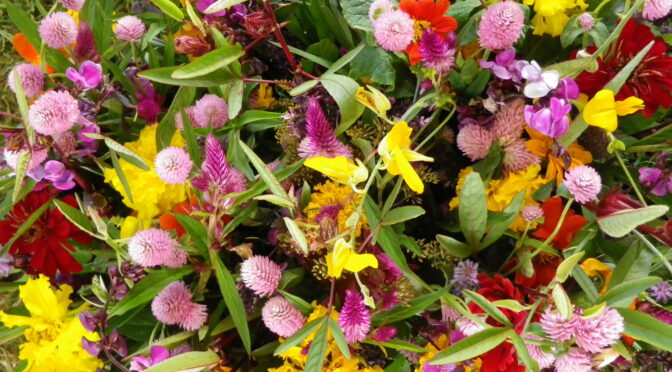While some folks are glad for some time off, November can be a sad time of year for many gardeners. In much of the US, all but the most cold-hardy plants have been hit by frost. Even in warmer areas, gardeners are now dealing with dwindling daylight. Thankfully the 2023 catalogs will be shipping out soon, and we can all start dreaming and planning for spring! Flowers seeds are one of my favorite things to peruse in winter and are the most affordable way to create a large flower garden come spring. Here are some of the easiest flowers to grow from seed, even for beginner gardeners.
Bachelor’s Buttons
- Annual
- Full Sun
- 65 Days to Bloom
- Blooms Mid-Summer – Fall
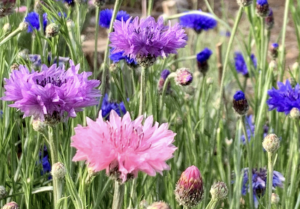
A favorite for cut flowers and dried arrangements, bachelor’s button varieties may have blue, red, rose, lavender, or maroon-black blooms. They’re great for attracting butterflies. It’s believed that they may have earned their name during the Victorian era when it was common to place flowers through the buttonholes of men’s suit coats.
Bachelor’s buttons can be direct sown in mid-spring when the soil temperatures reach about 60°F. Alternatively, they can be sown indoors about 6 to 8 weeks before your last frost and transplanted out.
Calendula
- Annual
- Full Sun
- 85 Days to Bloom
- Blooms Mid-Summer
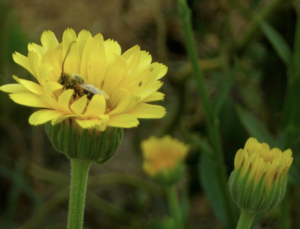
Beautiful and medicinal, you can use calendula flowers in bouquets, for food coloring, cake decorations, natural dye, saffron substitute, or salves and balms to calm mild skin irritations. Herbalists prize the strain Resina Calendula for its high resin content.
Direct sow calendula or start it indoors 6 to 8 weeks before your last frost. Seeds need darkness and germinate best around 55-65°F. Calendula often fades in the late summer heat but can be succession planted for fall harvests.
Cosmos
- Annual
- Full Sun – Partial Shade
- 45-68 Days to Bloom
- Blooms All Summer
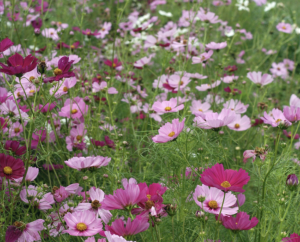
Cosmos will bloom all summer long, especially if you keep up with deadheading. You can find cosmos in various colors, including shades of orange, yellow, pink, purple, red, and white. They’re excellent for bouquets, and the seed heads attract birds. They self-seed readily.
Cosmos prefer full sun but tolerate partial shade, poor soils, and drought once established. Cosmos may be direct sown after all danger of frost has passed and the soil has reached 70°F. For extra early blooms, they can also be started indoors about 4 to 6 weeks before your last frost.
Four O’Clocks
- Annual
- Full Sun
- Blooms June to Fall
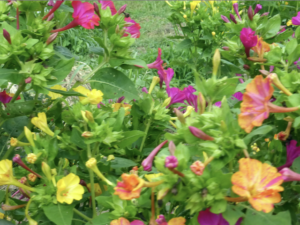
These neat flowers open around four in the afternoon and are pollinated by sphinx and hawk moths! They can be grown in the garden or pots. Marvel of Peru Four O’Clocks make excellent cut flowers and Don Pedros Mixed Four O’Clocks offer beautifully variegated flowers, primarily in shades of magenta or yellow.
Four O’Clocks do best when direct sown in late spring after the danger of frost has passed and soil temperatures are about 70°F. They do well in average, well-draining, moist soil, and full sun. They may self-seed.
Marigolds
- Annual
- Full Sun – Partial Shade
- 55-93 Days to Bloom
- Blooms All Summer
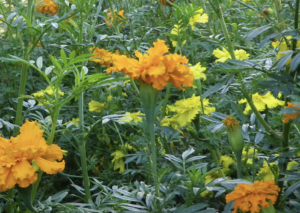
The name “marigold” is said to have been derived from “Mary’s gold” in reference to the golden color of many of these blooms and the Virgin Mary. Today, we often appreciate marigolds both for their beauty and their usefulness. Marigolds make excellent companion plants helping to deter nematodes and to attract beneficial insects such as lacewings, parasitic wasps, and ladybugs.
Marigolds prefer full sun but may tolerate some afternoon shade, especially in the hottest parts of the country. Marigolds may be direct sown after all danger of frost has passed and the soil has reached 70°F. Start them indoors 6 to 8 weeks before your last frost for extra early blooms.
Morning Glories
- Annual
- Full Sun
- 65 Days to Bloom
- Blooms from Early Summer to Fall
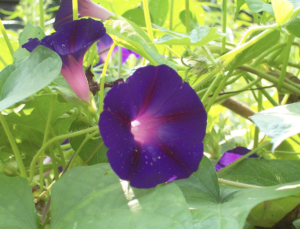
Did you know that the humble morning glory helped inspire Seed Savers Exchange and the whole heirloom movement? Grandpa Ott’s Morning Glory, a family heirloom from Diane Ott Whealy, was one of the first varieties to become part of SSE. These easy-to-grow vining flowers add beauty to the garden on trellises or can be grown in containers to spruce up porches.
Morning glories thrive in full sun. They self-seed readily. Before planting, soak seeds for two days, changing the water every 12 hours. Then, direct sow after all danger of frost has passed, and the soil has reached 70°F or sow indoors about six weeks before your last frost date.
Old Fashion Vining Petunias
- Annual
- Full Sun
- Blooms Early Summer to Fall
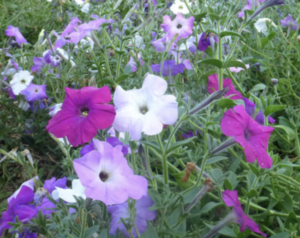
Sweet fragrance, soft colors, and a self-sowing nature gives Old Fashioned Vining Petunia a sure spot on this list. Our first regular staff member, Grandma Jean, recalls this heirloom petunia from her grandmother’s garden. Old Fashioned Vining dates back to the early 1900s, well before Grandma Jean was born.
Sow in flats or pots indoors in March or April and transplant out after the last frost. Ever-blooming and much hardier than modern varieties, this old favorite blooms into the fall when other annuals have faded and gone.
Poppies
- Annual
- Full Sun
- 55-65 Days to Bloom
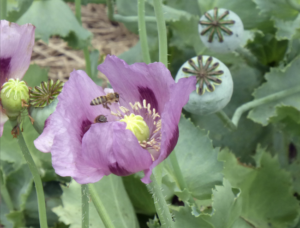
The stunning, easily recognizable, papery blooms are an excellent addition to any garden and can be found in various colors. Some varieties also produce delicious seeds for baking and seed pods that look stunning in dried arrangements.
Direct seed poppies in the fall or as soon as the soil can be worked in the spring. Sow approximately 1/4” deep; the seeds require darkness to germinate. Thin plants when the first true leaves appear.
Sunflowers
- Annual
- Full Sun
- 53-71 Days to Bloom
- Blooms July-August
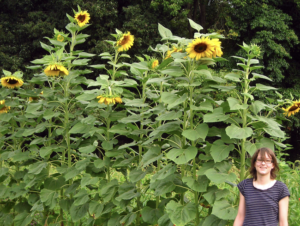
Giant, cheerful blooms are great for wildlife and fun for kids and adults alike. Some varieties offer excellent seed production, while others, like Velvet Queen, are well-suited for cut flower arrangements. Some archaeologists believe Native Americans may have cultivated sunflowers as early as 3000 BC.
Direct sow seeds after the danger of frost has passed. Taller varieties may require staking. Ideally, it would help if you planted them in a spot protected from heavy winds.
Zinnias
- Annual
- Full Sun
- 60-70 Days to Bloom
- Blooms All Summer
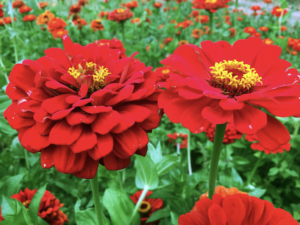
Excellent for cut flowers or just adding tons of long-lasting color to your flower beds, zinnias are one of the easiest flowers to grow from seed. Zinnias also offer a surprising variety with spiky petals like Cactus-Flowered or the double flowers of Red Beauty and a wide range of colors.
Direct sow after all danger of frost has passed and the soil has reached 70°F, or sow indoors 3 to 4 weeks before your last frost for extra early blooms. Sow several successions for a steady supply of cut flowers and keep up with deadheading.
Starting flowers from seed is the most affordable way to add color and beauty to your garden. These ten flowers are easy for beginner gardeners to start from seed and maintain. Add a few of these to your 2023 list for stunning beds, borders, and bouquets!

